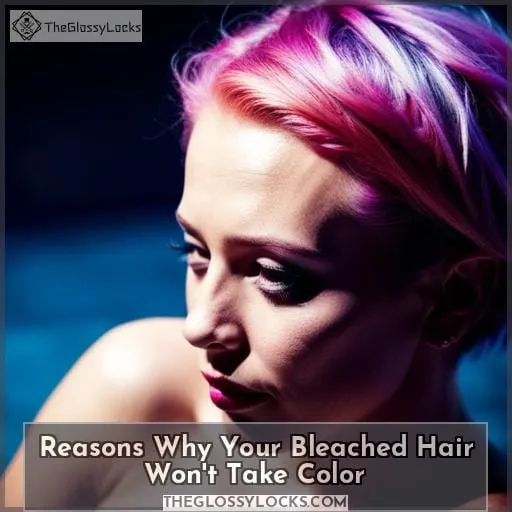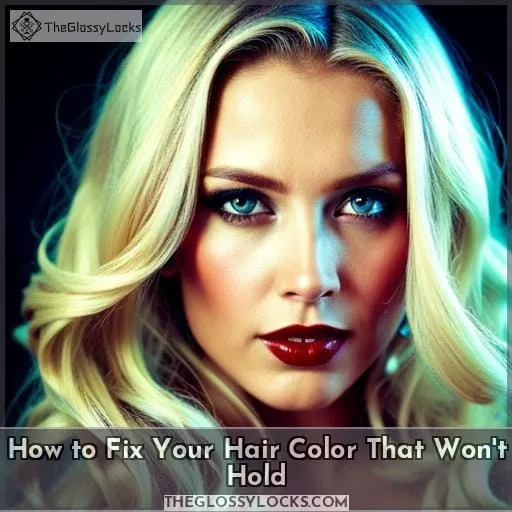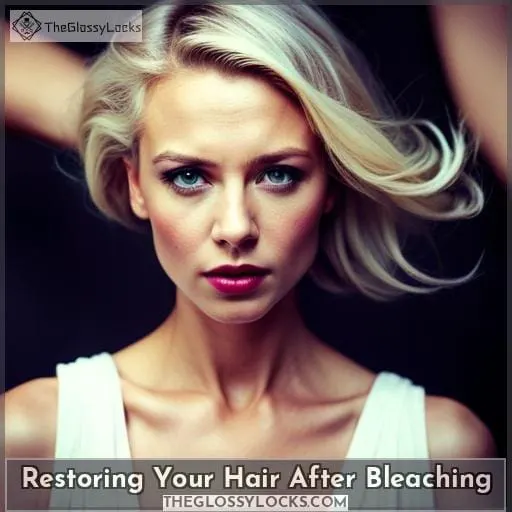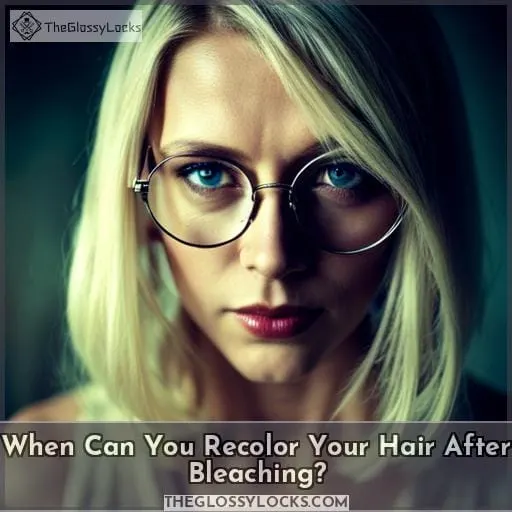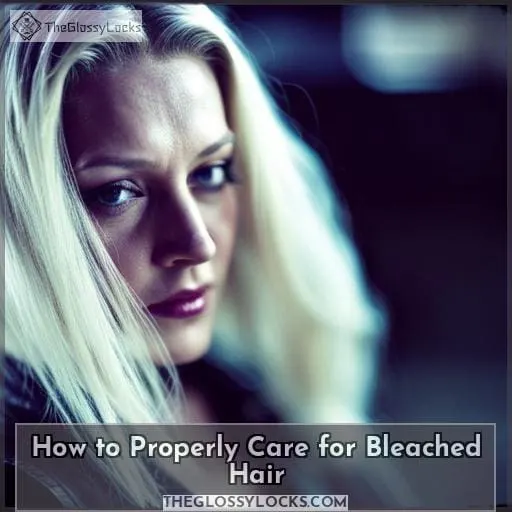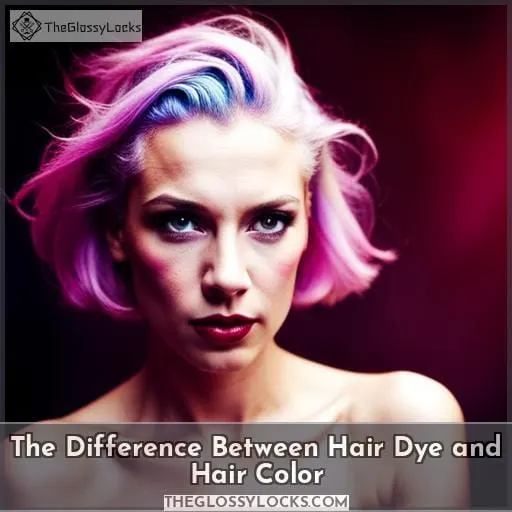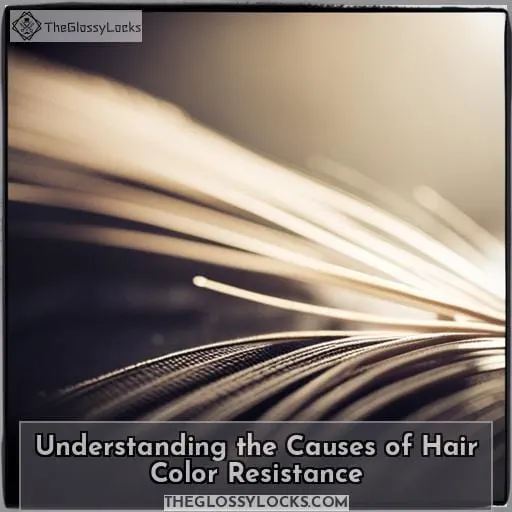This site is supported by our readers. We may earn a commission, at no cost to you, if you purchase through links.
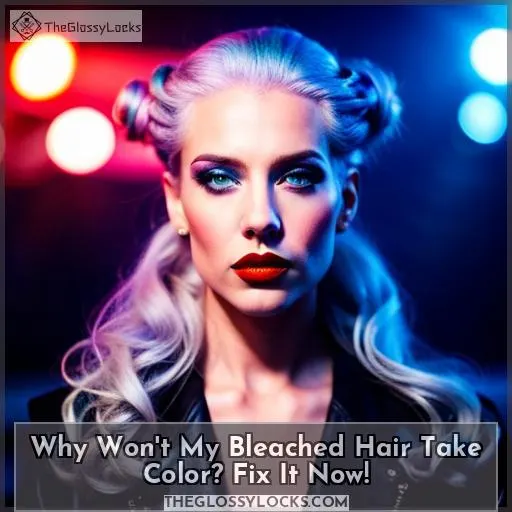 Frustrated with your bleached hair that won’t take color? You’re not alone. Many people have experienced this issue and often don’t know the cause or how to fix it. This article will examine why won’t my bleached hair take color, and provide tips on how to get better results when coloring your locks in the future.
Frustrated with your bleached hair that won’t take color? You’re not alone. Many people have experienced this issue and often don’t know the cause or how to fix it. This article will examine why won’t my bleached hair take color, and provide tips on how to get better results when coloring your locks in the future.
We’ll explore reasons like inadequate coloring time, expired dye, product buildup before the application of new colors, as well as addressing any damage caused by previous bleachings.
Additionally, we’ll look at proper care for colored hair so you can keep a vibrant hue longer without sacrificing the health of those luscious locks! So if you want to figure out why your newly-bleached tresses aren’t taking their desired tone, read on for answers!
Table Of Contents
- Key Takeaways
- Reasons Why Your Bleached Hair Won’t Take Color
- How to Fix Your Hair Color That Won’t Hold
- Restoring Your Hair After Bleaching
- When Can You Recolor Your Hair After Bleaching?
- How to Properly Care for Bleached Hair
- The Difference Between Hair Dye and Hair Color
- Understanding the Causes of Hair Color Resistance
- How to Remove Product Buildup Before Coloring
- Proper Application Techniques for Hair Color
- Conclusion
Key Takeaways
- Possible causes of bleached hair not taking color include inadequate coloring time, expired dye, product buildup, and previous bleach damage.
- To reduce damage and improve color uptake, consider using peroxide-free hair dye, deep conditioning and protein masks, and lower developer volumes.
- Proper preparation and application techniques, such as checking dye expiration dates, addressing product residue, and removing bleach residue, can help improve color results.
- Taking care of bleached hair through hydrating shampoos, reducing heat styling, and regular haircuts can also help with color penetration and maintenance.
Reasons Why Your Bleached Hair Won’t Take Color
If you’ve bleached your hair and attempted to dye it, only to find that the color isn’t taking properly, there may be a few possible reasons. Insufficient coloring time can cause the pigment of the dye not to penetrate deep enough into your hair shaft, while using an expired or outdated product might mean that its potency has been compromised.
Insufficient Coloring Time
If you’re finding that your hair color isn’t lasting, it could be due to insufficient coloring time. Processes like bleaching and dyeing require careful application techniques and specific processing times for optimal results.
Ensure proper usage of the right tools, correct timing, and efficient product selection for best results.
- Use appropriate coloring techniques to ensure even coverage
- Check dye expiration date before beginning the process
- Maximize color retention with well-balanced porosity levels
- Properly apply colors to minimize damage
Expired Hair Dye
Checking the expiration date of your hair dye is essential for successful coloring. Outdated products won’t give the desired results, so avoid residues and choose alternatives. Follow color uptake tips, such as pre-dye treatments and recoloring strategies, to help fix expired hair dye on bleached hair that isn’t taking color due to chemical treatments.
Residue From Hair Products
Before coloring your bleached hair, make sure to give it a thorough scrub to remove any residue from hair products that might prevent the dye from adhering. Product buildup can impact the absorption of color and the porosity of the hair, so using a clarifying shampoo is essential for successful dye application.
- Ensure proper removal of products before coloring
- Clarifying shampoo aids in removing residue
- Chemical treatments or buildup of products can restrict color absorption
- Hair porosity affects the adherence of dyes to bleached hair
- Residue from products hinders even distribution of colors
Residue From Bleach Mixture
Be sure to remove any residue from the bleach mixture before coloring your hair, as this can interfere with color retention. Hair porosity plays a major role in dye uptake, and bleached strands are especially vulnerable to damage.
Residue from chemical treatments or over-processing can further worsen root difficulties for taking color.
Careful application of hair dye is key for successful results after bleach damage is done – even if you’re using semi-permanent dyes instead! Clarifying shampoos and conditioners can help ensure all residues from the previous process have been removed prior to new color application – allowing your desired hue an easier transition onto your locks!
Peroxide-Free Hair Dye
Try using a peroxide-free hair dye to help your freshly bleached locks absorb color more effectively. Natural alternatives like henna and vegetable dyes are gentle options that won’t cause damage. Color absorption also improves when opting for non-chemical dyes, which can boost the longevity of your hair color applications.
How to Fix Your Hair Color That Won’t Hold
Having bleached hair that won’t take color can be a frustrating experience. To ensure your hair is properly accepting the dye, you should apply it correctly, remove any buildup before coloring, address any damage to the cuticle layer of your hair strands, and use lower volumes of developer when mixing.
Additionally, carefully select colors to create desired results without over-processing or damaging your locks further.
Properly Applying Color
To ensure your hair color lasts, proper application is key. Research shows many don’t know how to prepare their hair – you’re not alone! Learn the techniques for successful coloring: use a lower volume developer and carefully choose colors; hydrate bleached locks with nourishing masks; brush gently to prevent damage.
Removing Buildup Before Coloring
Before you color your hair, it’s important to remove any buildup that could hinder the dye from being absorbed. Clarify with a shampoo specifically designed to strip away product residue and excess oils.
Uncovering healthy strands helps ensure even absorption of color and better long-term results.
Addressing Hair Damage
It is essential to address hair damage before coloring, as weakened strands can make it difficult for color to stick. To repair your bleached hair, opt for deep conditioning treatments and protein masks that will nourish and strengthen the cuticles.
For porous locks, use a product formulated specifically for this type of porosity issue prior to dyeing. Seek out products designed with color restoration in mind; they will help you recover some of what was lost during the bleaching process.
Using Lower Volumes of Developer
Choosing a lower volume of developer can help reduce the damage caused by bleaching, strengthen cuticles, and aid color retention. Porous hair needs special attention when selecting a developer for the best results; too high of strength could be damaging to already weakened strands.
A low-volume dye application with an even distribution using a color brush will provide your bleached hair with reliable coverage while minimizing further damage.
Selecting Colors Carefully
Carefully select colors when coloring your hair to ensure you get the look you desire. Color selection, compatibility, shade choice, and suitability all play a role in hue matching for bleached hair. Consider color application techniques, timing, and product types for the best results.
Restoring Your Hair After Bleaching
After bleaching, restoring your hair may seem like a daunting task – but how can you get it back to looking healthy and vibrant? To begin with, the first step should be hair repair. This means using nourishing masks and conditioning treatments that help strengthen cuticles while increasing moisture levels in strands.
Afterward, proceed to color restoration by carefully selecting dye colors as well as lower developer volumes for less damage than usual. It is recommended to use products specifically for porous hair before coloring. Additionally, hydrating products are essential if dealing with bleached locks.
Finally, use semi-permanent dyes where possible. This will create longer-lasting results without over-processing your mane or requiring too much time between each application.
Hair rejuvenation after bleach requires patience; however, it is worth investing in order to restore its natural vibrancy and shine without compromising the health of your tresses post-chemical treatment(s).
When Can You Recolor Your Hair After Bleaching?
Before you consider recoloring your hair after bleaching, it’s important to understand how long you should wait before doing so. If the bleach has been sitting on your scalp for more than 15 minutes, then you may want to give it at least a week or two before attempting any color applications.
This will allow plenty of time for the chemical damage caused by bleach to heal and reduce the risk of additional damage from coloring too soon. Additionally, allowing ample time between applications will ensure that any remaining product residue is gone, leaving behind healthier hair with improved dye uptake potential.
To maximize success when recoloring bleached hair, select an appropriate shade based on the desired outcome and choose a high-quality professional-grade dye rather than box dyes, which can be harsher on already lightened strands.
Be sure not to use overly hot water during rinsing as this can cause further cuticle lifting, leading to compromised bonds within each strand. This can result in duller colors post-dye application or fading quicker over time due to improper absorption into weakened follicles and greater susceptibility towards environmental factors like UV rays or harsh chlorine pool water exposure both pre-and post-coloring treatments.
Ultimately, being mindful about timing and using quality products are key steps for successful color results while avoiding common mistakes with unpredictable results.
How to Properly Care for Bleached Hair
You’ve bleached your hair and now the color won’t take. Don’t worry, it’s a common issue that can be addressed with proper care for bleached hair.
Start using hydrating shampoos to help maintain healthy moisture levels in your strands.
Use protein treatments periodically to strengthen cuticles and reduce breakage from chemical treatments.
Nourish with conditioning masks regularly to increase elasticity and prevent porosity buildup after coloring processes like bleach.
Reduce heat styling as much as possible, or try using cooler settings when you must use hot tools for styling purposes.
Cut down on washing frequency; this will eliminate product build-up which can cause difficulty when trying to apply new color onto already-treated tresses.
All of these precautions are important if you want to obtain successful results when applying new colors onto pre-bleached hair again at some point in the future! The key is understanding how frequent washings, heated tools usage, along with environmental factors all play into why sometimes colors don’t hold properly on certain hair types – especially those that have been through extensive chemical processing such as lightening services over time.
The Difference Between Hair Dye and Hair Color
Understanding the difference between hair dye and hair color is key to achieving optimal results. Hair dye, also known as box color, is a more affordable option that can be found in most drugstores and supermarkets.
It’s a single-process solution that allows you to quickly change your shade without bleach or other chemical treatments.
However, the less expensive dyes tend to fade faster, so they don’t provide long-lasting results for color retention purposes. Professional hair colors are usually of better quality because they contain special ingredients that help maintain pigment for longer periods of time while protecting against damage caused by bleaching or harsh chemicals in home kits.
Additionally, professional salons offer specialized services such as customized coloring techniques like double processing. This technique is helpful when transitioning from very dark shades into lighter ones with fewer risks involved compared to using boxed dyes alone.
Ultimately, these measures combined will ensure an even application process resulting in healthier-looking locks overall, free from any unnecessary breakage primarily caused by damaged cuticles.
Understanding the Causes of Hair Color Resistance
Are you trying to understand why your bleached hair won’t take color? Inadequate coloring time might be the culprit. The amount of time a dye is left in contact with the hair can determine how well it absorbs, and if not enough time is given for absorption, then poor results may occur.
Inadequate Coloring Time
If you don’t leave the hair dye on long enough, it can be difficult for your strands to absorb color properly. In fact, studies show that letting a full-color application sit for at least 45 minutes is essential to achieving optimal results.
To ensure successful coloring and maximum color retention, fix timing issues by following recommended coloring times. Apply dye evenly while addressing any bleach damage or chemical treatments. Select hair dye colors based on porosity level.
Too little time can cause inadequate absorption of the product, leading to undesired hues.
Product Residue
Be sure to remove any product residue from your hair before coloring, as leftover products can prevent even dye uptake. Dye expiration and chemical treatments are two common causes of color resistance in bleached hair.
Product buildup can also negatively affect the outcome of a color application, making it essential to use clarifying shampoo prior to coloring. Properly removing any remaining residue will greatly increase the chances that your desired hue will take hold and last for longer periods without fading or washing out prematurely.
Residue From Bleach
When coloring bleached hair, residue from the bleach mixture can prevent dye uptake and cause frustration. Properly prepping your hair is essential for optimal color absorption. This includes removing any residue that may have been left behind by the bleach.
The process of lightening often strips away moisture, leaving it more porous and less likely to absorb color evenly. To ensure successful results, use a clarifying shampoo or vinegar rinse prior to application.
This will help remove any remaining chemical buildup on your strands. It will also help create an even canvas for better dye uptake and retention over time.
Take care when dealing with damaged locks due to excessive bleaching. They are more prone to further damage during heat styling or regular maintenance, such as trimming split ends caused by harsh chemical treatments.
How to Remove Product Buildup Before Coloring
If you’ve noticed that your bleached hair won’t hold color, the root cause of this issue is likely due to product buildup or chemical treatments. The best way to prevent this from happening is by removing any existing product residue and properly preparing the hair before coloring.
A good pre-color treatment will help ensure effective dye application and improve color longevity for a longer-lasting result. To do so, start with a clarifying shampoo to remove any buildup on your scalp and strands.
Then, use a deep cleansing conditioner to further cleanse your hair and a purple shampoo to prevent brassiness in your lightened locks.
Finally, avoid over-washing after applying dye, as this can strip away its vibrancy and cause fading quickly.
Proper Application Techniques for Hair Color
To ensure your hair color turns out as you expect, it’s important to understand proper application techniques. Before applying the dye, use a clarifying shampoo to rid your hair of any product residue that could affect the outcome of coloring.
To avoid further damage caused by bleaching and chemical treatments, always opt for lower developer volumes when dying your hair. If transitioning from dark to light colors or vice versa, consider utilizing the double process technique.
When using permanent dyes, be sure not to apply them too close to the scalp in order to prevent skin irritation and uneven fading over time. The root area tends to absorb the dye better than the tips since they are generally coarser there.
After selecting the desired shade, never forget about necessary post-coloring nourishment like masks and protein treatments. These will strengthen the cuticles, allowing better retention of the applied pigments.
Last but not least, regular haircuts are a must in case oily roots create difficulty for color penetration into the strand shafts, thus preventing successful uptake.
Conclusion
It’s easy to see why your bleached hair won’t take color – it may be due to insufficient coloring time, expired hair dye, or damage to the hair from over-processing. But with a few simple steps, you can restore your hair to its original, vibrant color.
First, properly apply the hair dye and address any hair damage. Use lower volumes of developer and select colors carefully to minimize damage.
To restore your hair after bleaching, use nourishing masks and conditioning treatments, strengthen your cuticles with protein treatments, and reduce heat styling and over-washing.
Finally, remove any product buildup before coloring, and understand that it may take some time before your bleached hair will take color again. With these tips in mind, you’ll be back to having vibrant, beautiful hair in no time.

